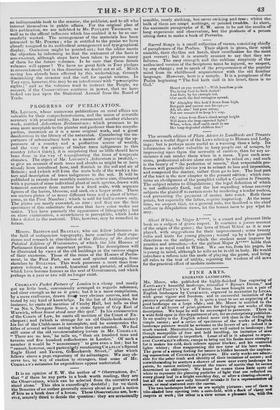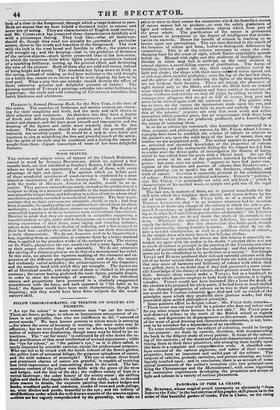FINE ARTS.
ENGRAVED LANDSCAPES.
MR. Moost, who published the highly-finished line engraving Of EAsTLAKE's beautiful landscape, miscalled " Byron's Dream," and another of PitouT'S View of Venice, has now brought out a pair of English landscapes by CONSTABLE, engraved in mezzotint by levees, with great vigour and freedom, and in successful imitation of the painter's peculiar manner. It is quite a treat to see an engraving of a good landscape on a large Ale; and Mr. Moore is entitled to the thanks of all lovers of print-pictures for bringing out works of this description. We hope he will be encouraged to persevere. There is a wide field open in this department of art, for an enterprising publisher. In no quality is the English school more rich than in the feeling for simple nature ; and a series of specimens of the works of English- landscape painters would be welcome to the lovers of art : indeed it is much wanted. Mezzotint is, however, not well suited to landscape ; for though susceptible of free and bold handling, its imitation of nice gradations of colour is imperfect. Least of all is it adapted to repre- sent CoNsTABLE's effects, except to bring out his faults more strongly: for it makes his cold, dark colours appear blacker' and his scattered lights whiter; thus exaggerating the raw tone of his later works. The germ of a strong feeling for nature is hidden beneath the napless.. ing mannerism of CONSTABLE'S pictures. His early works are admir- able for the sober truth and identity of their imitation of nature ; and notwithstanding be scatters a shower of snow over every landscape he paints, be cannot entirely conceal the traces of merits that he seems determined to obliterate. We know he means these little spots of white to represent the glancing particles of light that are reflected on every glossy leaf in a bright sunshiny day, or afters clearing-shower but all the world save only himself mistake it for a representation of Snow, or meal scattered over the canvas. The two landscapes before us are apright pictures: one of them a trie-shaded lane opening into a coin-field, with a flock of sheep and reapers at work ; the other is a view across a pleasant lea, with the leek of a river in the foreground, through which a large is about to pass. Both are scenes that we have beheld • thousand times in nature, and sever tire of seeing. They are characteristic of English rural scenery; and Mr. ConeyAna has preserved these characteristics faithfully and with a picturesque feeling. They look like—what all landscapec should do, though they need not actually be—portraits of particular scenes, down to the weeds and brambles in the foreground. The view with the lock is the mest broad and forcible in effect ; the masses are well wrought up; and the keeping—that is, the gradation of distances of the various objects—much better preserved than in the lane-scene. in which the numerous little white lights produce a spottiness instead of a sparkling brilliancy, cutting up the general effect, and destroying the tone of the picture. Both of them also are cold and snowy, instead of being bright and sunny. The shepherd-boy lying down to think at the spring, instead of making us feel how welcome is the cold draught on • sultry day, causes us to shiver as if he were dipping his face in an iced pool. What a pity that one mistake should destroy the effect of these otherwise genuine and delightful pictures of nature! The glowing warmth of TURNER'S paintings subsides into sober brilliancy in engravings : the crude and cold colouring of CONSTABLE translates into harsh blackness and whiteness.



























 Previous page
Previous page